Type Modular Floor area 2,000 m² Construction started 15 January 1956 | Elevation 20 m Architecture firm Hugh Broughton | |
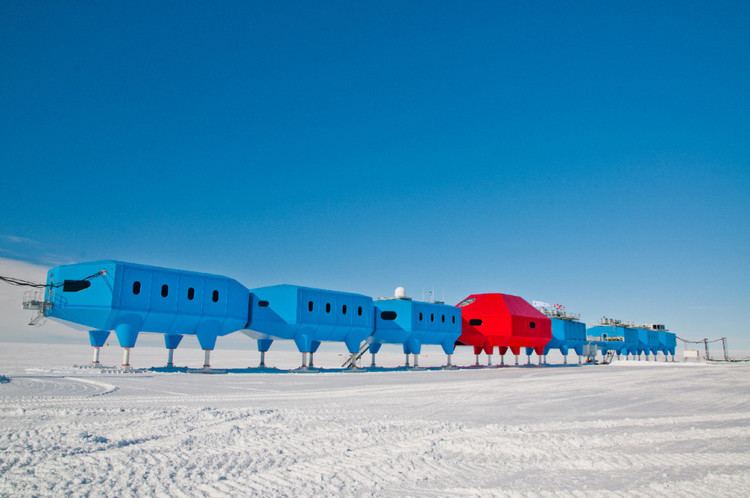 | ||
Location Brunt Ice ShelfCaird CoastAntarctica Opened 5 February 2013 (Halley VI) Owners British Antarctic Survey, Natural Environment Research Council | ||
Halley research station being there
Halley Research Station, run by the British Antarctic Survey (BAS), is a scientific research station located on the Brunt Ice Shelf floating on the Weddell Sea in Antarctica. As with the German Neumayer-Station III it is built on an ice shelf floating on the sea, versus being located on solid land on the continent of Antarctica. Because the ice shelf is slowly moving towards the open ocean it will eventually calve off creating a drifting iceberg.
Contents
- Halley research station being there
- Halley research station antarctica winter 2015
- History
- The buildings
- Halley I
- Halley II
- Halley III
- Halley IV
- Halley V
- Halley VI
- Design competition
- Design elements
- Relocation
- Environment
- Inhabitants
- Base life
- References
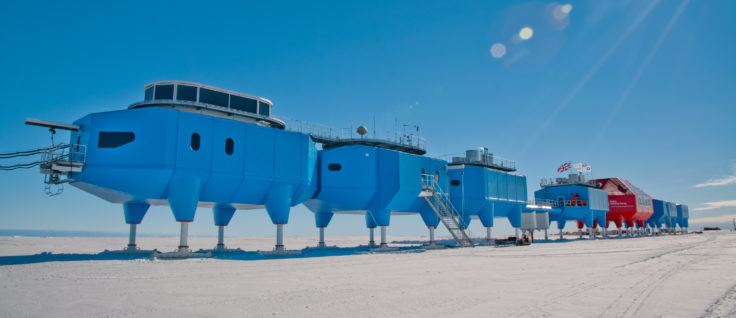
In 2002, the BAS realized there was a calving event that would destroy Halley V, so a competition was undertaken to design a replacement station. The current base structure, the Halley VI, is notable for being the first fully relocatable research station in the world, and is distinguishable by its colourful modular structure that is built upon huge hydraulic skis.
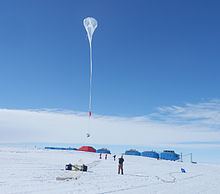
It is a British research facility dedicated to the study of the Earth's atmosphere. Measurements from Halley led to the discovery of the ozone hole in 1985.
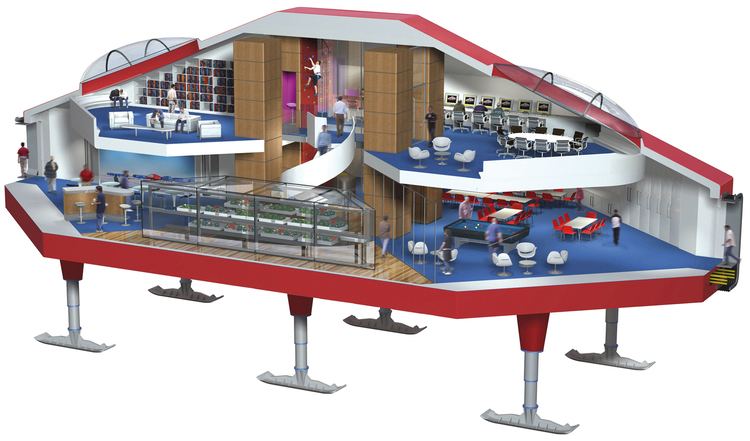
Halley research station antarctica winter 2015
History
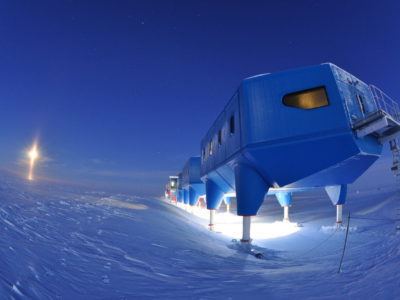
Halley was founded in 1956, for the International Geophysical Year of 1957–1958, by an expedition from the Royal Society. The bay where the expedition decided to set up their base was named Halley Bay, after the astronomer Edmond Halley. The name was changed to Halley in 1977 as the original bay had disappeared due to changes in the ice shelf. The latest station, Halley VI, was officially opened in February 2013 after a test winter.
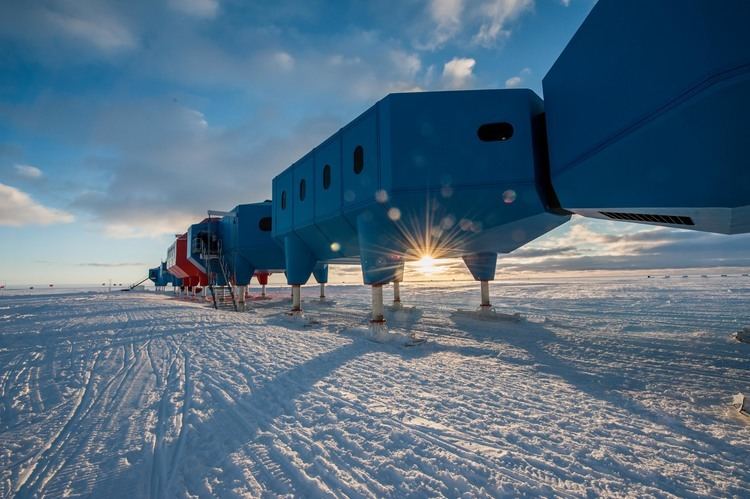
On 30 July 2014, the station lost its electrical and heating supply for 19 hours. During the outage, there were record low temperatures. Power was partially restored, but all science activities, apart from meteorological observations essential for weather forecasting, were suspended. Plans were made to vacate some of the eight modules and to shelter in the remaining few that still had heat.
The buildings
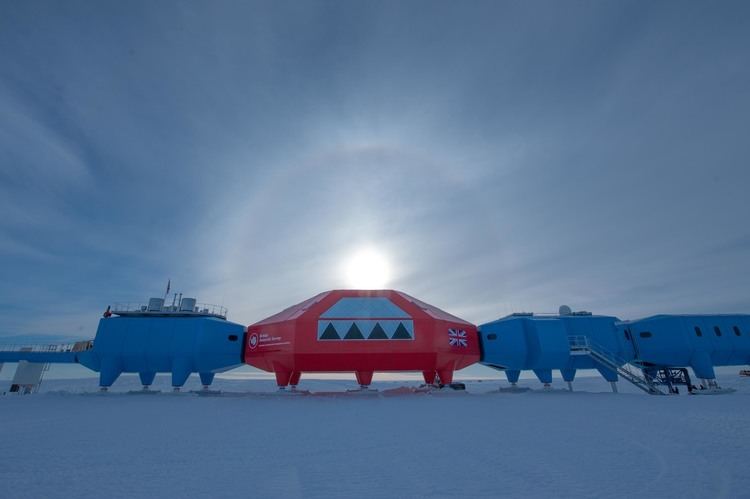
There have been five previous bases at Halley. Various construction methods have been tried, from unprotected wooden huts to steel tunnels. The first four were all buried by snow accumulation and crushed until they were uninhabitable.
Halley I
Halley II
Halley III
Halley IV
Halley V
Halley VI
It is a structure which, like Halley V, is jacked up on hydraulic legs to keep it above the accumulation of snow. Unlike Halley V, there are retractable giant skis on the bottom of these legs, which allow the building to be relocated periodically.
It is a string of eight modules, each on stilts with skis.
The Drewry summer accommodation building and the garage from Halley V were dragged to the Halley VI location and continue to be used.
Design competition
An architectural design competition was launched by RIBA Competitions and the British Antarctic Survey in June 2004 to provide a new design for Halley VI. The competition was entered by a number of architectural and engineering firms. The winning design, by Faber Maunsell and Hugh Broughton Architects was chosen in July 2005.
Halley VI was built in Cape Town, South Africa by a South African consortium. Servaccomm supplied modular accommodation pods for the new station through Galliford Try International. The contract was for the manufacture of 26 pods in total, installed in eight modules, which provides fully serviced accommodation for 32 people. The first sections were shipped to Antarctica in December 2007. It was assembled next to Halley V, then dragged one-by-one 15 km and reconnected.
Halley VI Station was officially opened in Antarctica on 5 February 2013. Kirk Watson, a filmmaker from Scotland, recorded the building of this space age station over a 4-year period. A trailer with further information can be seen at the links below. A description of the engineering challenges and the creation of the consortium was provided by Adam Rutherford to coincide with an exhibition in Glasgow.
Design elements
A focus of the new architecture was the desire to improve the living conditions of the scientists and staff on the station. Solutions included consulting a color psychologist to create a special color palette to offset the more than 100 days of darkness each year, daylight simulation lamp alarm clocks to address biorhythm issues, the use of special wood veneers to imbue the scent of nature and address the lack of green growth, as well as lighting design and space planning to address social interaction needs and issues of living and working in isolation.
Another priority of the structure construction was to have the least environmental impact on the ice as possible.
Relocation
The British Antarctic Survey announced that it intended to move Halley VI to a new site in summer 2016-2017. A large crack had been propagating through the ice and threatened to cut the station off from the main body of the ice shelf, prompting the decision to move. The planned move would see the station shifted 23 kilometres (14 mi) from its previous site and would be the first time the station had been moved since it became operational in 2012.
Having moved the station, further concerns about a further crack which had been discovered on 31 October 2016 led the BAS to announce that they would withdraw their staff from the base in March 2017, for the duration of the Antarctic winter. In February 2017, The base completed their relocation which is now 23km further "inland" from the crack.
Environment
Temperatures at Halley rarely rise above 0 °C although temperatures around -10 °C are common on sunny summer days. Typical winter temperatures are below -20 °C with extreme lows of around -55 °C.
Winds are predominantly from the east; strong winds often picking up the dusty surface snow reducing visibility to a few metres.
One of the reasons for the location of Halley is that it is under the auroral oval, making it ideally located for geospace research and resulting in frequent displays of the Aurora Australis overhead. These are easiest to see during the 105 days (29 Apr - 13 Aug) when the Sun does not rise above the horizon.
Inhabitants
During the winter months there are usually around 14 overwintering staff. In a typical winter the team is isolated from when the last ship leaves in late February until the first plane arrives in early November. In the peak summer period, from late December to late February, staff numbers increase to around 70.
Sometimes, none of the wintering team are scientists. Most are the technical specialists required to keep the station and the scientific experiments running. The 2012 wintering team at Halley included a chef, a doctor, a communications manager, a vehicle mechanic, an electrician, a plumber, a field assistant, two electronics engineers, two meteorologists and a data manager. In addition there is a Winter Base Commander who is sworn in as a magistrate prior to deployment. Their main role is to oversee the day-to-day management of the station.
1996 saw the first female winterers at Halley. There have been at least two women wintering every year until 2009.
Base life
Life in Antarctica is dominated by the seasons, with a short, hectic summer and a long winter. In bases such as Halley that are resupplied by sea, the most significant event of the year is the arrival of the resupply ship (currently the RRS Ernest Shackleton, before 1999 the RRS Bransfield) in late December. This is followed by intense activity to unload all supplies before the ship has to leave again; typically, this is done in less than two weeks.
The Halley summer season runs from early November when the first plane lands, until late February when the last ship leaves.
Significant dates in the winter are sundown (last day when the Sun can be seen) on Apr 29, midwinter (June 21) and sunrise (first day when the Sun rises after winter) on Aug 13. Traditionally, the oldest person on base lowers the tattered flag on sundown and the youngest raises a new one on sunrise. Midwinter is a week's holiday, during which a member of the wintering team is chosen to keep the old flag. Handmade presents are also exchanged amongst the wintering team.
